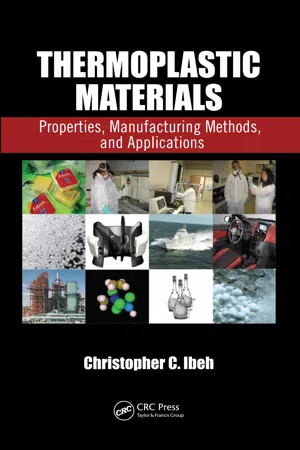
eBook - PDF
Thermoplastic Materials
Properties, Manufacturing Methods, and Applications
- 640 pages
- English
- PDF
- Available on iOS & Android
eBook - PDF
About this book
Practical and affordable, thermoplastics account for more than 90 percent of all plastic materials manufactured. That so many varieties are now available, speaks to the idea that while there is no one perfect material, it is possible to find a material that fits for every application. However, selecting that right material is no small challenge.Ans
Frequently asked questions
Yes, you can cancel anytime from the Subscription tab in your account settings on the Perlego website. Your subscription will stay active until the end of your current billing period. Learn how to cancel your subscription.
At the moment all of our mobile-responsive ePub books are available to download via the app. Most of our PDFs are also available to download and we're working on making the final remaining ones downloadable now. Learn more here.
Perlego offers two plans: Essential and Complete
- Essential is ideal for learners and professionals who enjoy exploring a wide range of subjects. Access the Essential Library with 800,000+ trusted titles and best-sellers across business, personal growth, and the humanities. Includes unlimited reading time and Standard Read Aloud voice.
- Complete: Perfect for advanced learners and researchers needing full, unrestricted access. Unlock 1.4M+ books across hundreds of subjects, including academic and specialized titles. The Complete Plan also includes advanced features like Premium Read Aloud and Research Assistant.
We are an online textbook subscription service, where you can get access to an entire online library for less than the price of a single book per month. With over 1 million books across 1000+ topics, we’ve got you covered! Learn more here.
Look out for the read-aloud symbol on your next book to see if you can listen to it. The read-aloud tool reads text aloud for you, highlighting the text as it is being read. You can pause it, speed it up and slow it down. Learn more here.
Yes! You can use the Perlego app on both iOS or Android devices to read anytime, anywhere — even offline. Perfect for commutes or when you’re on the go.
Please note we cannot support devices running on iOS 13 and Android 7 or earlier. Learn more about using the app.
Please note we cannot support devices running on iOS 13 and Android 7 or earlier. Learn more about using the app.
Yes, you can access Thermoplastic Materials by Christopher C. Ibeh in PDF and/or ePUB format, as well as other popular books in Technology & Engineering & Materials Science. We have over one million books available in our catalogue for you to explore.
Information

Introduction
and
History
of the
Plastics
Industry
3
1.2
Overview
of
the
Plastics
Industry
Using
the
“form
of
usage”
criterion,
there
are
about
10
main
polymer-based
industries,
namely,
•
Adhesives
•
Coatings
•
Composites
•
Elastomers
(rubbers)
•
Fibers
•
Films
•
Foams
•
Insulation
•
Plastics
•
Sheets
and
rods
•
Others
The
plastics
industry
is
by
far
the
largest
of
the
main
polymer-based
industries.
In
1978,
the
consumption
volume
(U.S.
sales
and
production
figures,
Figure
1.2)
of
polymers
[3,7,8]
used
in
the
making
of
plastics
was
about
16
billion
kilo-
grams
(16
×
10
9
);
this
figure
rose
to
27.9
billion
kilograms
(61.5
billion
pounds)
in
1990,
100
billion
pounds
in
2000
and
113.2
billion
in
2006.
The
consumption
0
20
40
60
80
100
120
5
4
3
2
1
Years
(1
=
1978;
2
=
1990;
3
=
2000;
4
=
2002;
5
=
2006)
Consumption
(billions
of
pounds)
Plastics
Fibers
Elastomers
FIGURE
1.2
U.S.
consumption
volume
in
billions
of
pounds
for
the
three
largest
polymer-based
industries.
Table of contents
- Front Cover
- Contents
- Preface
- Author
- Chapter 1: Introduction and History of the Plastics Industry
- Chapter 2: Raw Materials and Their Sources: “The Plastics Tree”
- Chapter 3: Basic Structures and Characteristics of Polymers and Plastics
- Chapter 4: Molecular Weight of Polymers
- Chapter 5: Polymerization (Resinification) Methods
- Chapter 6: Crystallinity and Crystallization in Polymers and Plastics
- Chapter 7: Classification of Thermoplastics
- Chapter 8: Permeability and Environmental-Stress-Cracking Resistance of Thermoplastics: Barrier Properties and Packaging Applications of Polymers
- Chapter 9: Polyolefins: Polyethylene, Polypropylene, and Their Copolymers
- Chapter 10: Polypropylene
- Chapter 11: Olefin Copolymers of Ethylene and Propylene
- Chapter 12: The Vinyls: PVC and Copolymers
- Chapter 13: Polystyrene and Copolymers
- Chapter 14: Acrylic (Acrylate) Family
- Chapter 15: Polyester Family
- Chapter 16: Nylon (Polyamide) Family
- Chapter 17: Polycarbonates
- Chapter 18: Polyacetals
- Chapter 19: Polyphenylene Sulfides
- Chapter 20: Fluorocarbons (Teflon Family)
- Chapter 21: Liquid Crystalline Polymers
- Chapter 22: Polysulfones
- Chapter 23: Polyimide Family
- Chapter 24: PEEK
- Chapter 25: Polyphenylene Oxide
- Chapter 26: Cellulosics
- Chapter 27: Functionalized Thermoplastic and Elastomers
- Chapter 28: Plastics Nanocomposites
- Chapter 29: Plastics and Sustainability: A Life Cycle Cost Analysis Approach
- Back Cover